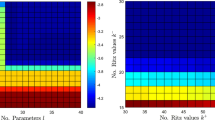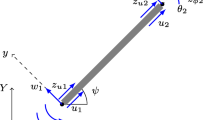Abstract
A topology and shape optimization technique using the homogenization method was developed for stiffness of a linearly elastic structure by Bendsøe and Kikuchi (1988), Suzuki and Kikuchi (1990, 1991), and others. This method has also been extended to deal with an optimal reinforcement problem for a free vibration structure by Diaz and Kikuchi (1992). In this paper, we consider a frequency response optimization problem for both the optimal layout and the reinforcement of an elastic structure. First, the structural optimization problem is transformed to an Optimal Material Distribution problem (OMD) introducing microscale voids, and then the homogenization method is employed to determine and equivalent “averaged” structural analysis model. A new optimization algorithm, which is derived from a Sequential Approximate Optimization approach (SAO) with the dual method, is presented to solve the present optimization problem. This optimization algorithm is different from the CONLIN (Fleury 1986) and MMA (Svanderg 1987), and it is based on a simpler idea that employs a shifted Lagrangian function to make a convex approximation. The new algorithm is called “Modified Optimality Criteria method (MOC)” because it can be reduced to the traditional OC method by using a zero value for the shift parameter. Two sensitivity analysis methods, the Direct Frequency Response method (DFR) and the Modal Frequency Response method (MFR), are employed to calculate the sensitivities of the object functions. Finally, three examples are given to show the feasibility of the present approach.
Similar content being viewed by others
References
Bendsøe, M. P. (1989): Optimal shape design as a material distribution problem. Struct. Optimization 1, 193–202
Bendsøe, M. P.; Kikuchi, N. (1988): Generating optimal topologies in structural design using a homogenization method. Comput. Methods Appl. Mech. Energ. 71, 197–224
Bendsøe, M. P.; Diaz, A.; Kikuchi, N. (1992): Topology and generalized layout optimization of elastic structures. In: Bendsøe, M. P.; Soates, C. A. M. (eds): Topology design of structures, pp. 159–205. NATO ASI Series, Kluwer
Berke, L.; Venkayya, V. B. (1974): Review of optimality criteria approaches to structural optimization. In: Schmit, L. A. (ed.): Structural optimization symposium, pp. 23–34. New York
Choi, K. K.; Haug, E. J. (1981): Optimization of structures with repeated eignevalues. In: Haug, E. J.; Cea, J. (eds.): Optimization of distributed parameter structures Volume I, pp. 219–277. The Netherlands: Sijthoff & Noordhoff
Diaz, A.; Kikuchi, N. (1992): Solutions to shape and topology eigenvalue optimization problems using a homogenization method. Preprint, Dept. of Mech. Engng., Michigan State University, East Lansing, MI
Fleury, C.; Braibant, V. (1986): Structural optimization: a new dual method using mixed variables. Internat. J. Numer. Methods Engrg. 23, 409–428
Haftka, R. T.; Grandhi, R. V. (1986): Structural shape optimization — a survey. Comput. Methods. Appl. Mech. Energ. 57, 91–106
Haftka, R. T.; Gurdal, Z. (1992): Elements of structural optimization. Third revised and expanded edition. The Netherlands: Kluwer
Kirsch, U. (1989): Optimum topologies of structures. Appl. Mech. Rev. 42, 223–239
Ma, Z.-D.; Hagiwara, I. (1991a): Sensitivity analysis methods for coupled acoustic-structural systems, part 2: direct frequency response and its senstivities. AIAA Journal 29, 1796–1801
Ma, Z.-D.; Hagiwara, I. (1991b): Improved mode-superposition technique for modal frequency response analysis of coupled acoustic-structural systems. AIAA Journal 29, 1796–1801
Ma, Z.-D.; Hagiwara, I. (1992): Sensitivity calculation methods for modal frequency response of coupled acoustic-structural system. JSME International Journal Series III, 35, 12–21
Olhoff, N.; Bendsøe, M. P.; Rasmussen, J. (1991): On CAD-integrated structural topology and design optimization. Comput. Methods Appl. Mech. Energ. 89, 259–279
Olhoff, N. N.; Taylor, J. E. (1983): On structural optimization. J. Appl. Mech. 50, 1134–1151
Rozvany, G. I. N. (1992): Layout theory for grid-type structures. In: Bendsøe, M. P.; Soates, C. A. M. (eds): Topology design of structures, pp. 251–272. NATO ASI Series, The Netherlands: Kluwer
Suzuki, K.; Kikuchi, N. (1990): Generalized layout optimization of shape and topology in three-dimensional shell structures. Rept. No. 90-05, Dept. Mich. Engrg. and Appl. Mech., Comp. Mech. Lab., University of Michigan, USA
Suzuki, K.; Kikuchi, N. (1991): A homogenization method for shape and topology optimization. Comput. Methods Appl. Mech. Energ. 93, 291–318
Sanchez-Plencia, E. (1980): Non-homogeneous media and vibration theory. Lecture notes in physica 127, Berlin, Heidelberg, New York: Springer
Svanberg, K. (1987): The method of moving asymptotes — a new method for structural optimization. Internat. J. Numer. Methods Engrg. 24, 359–373
Author information
Authors and Affiliations
Additional information
Communicated by S. N. Atluri, May 28, 1993
Rights and permissions
About this article
Cite this article
Ma, Z.D., Kikuchi, N. & Hagiwara, I. Structural topology and shape optimization for a frequency response problem. Computational Mechanics 13, 157–174 (1993). https://doi.org/10.1007/BF00370133
Issue Date:
DOI: https://doi.org/10.1007/BF00370133




